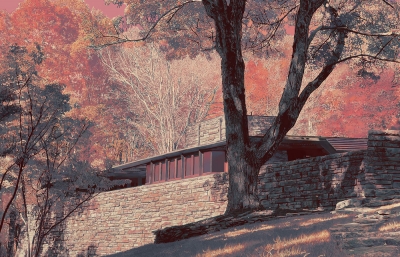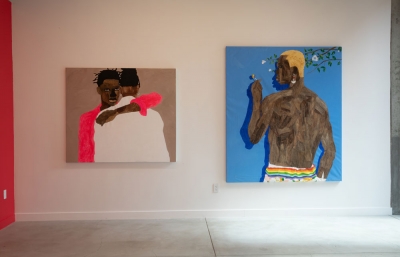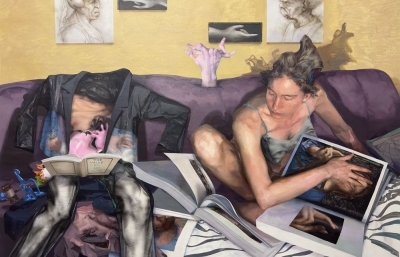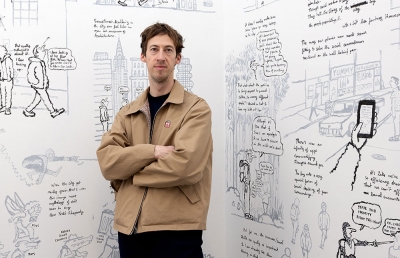Now that Aesop Rock's new album, Malibu Ken, is out now, we want to revisit Aesop's interview with Malibu Ken cover artist, Gunsho.
Blood and mucus and things that leave a stain—New England’s purveyor of the grotesque, Gunsho, combines influences from comics, mythology, and the occult to illustrate a cast of warped creatures that won’t be invited to dinner anytime soon. Whether working on his long-term project of interpreting the 72 demons of the Ars Goetia, or blasting out gushy, one-off monsters in desperate need of dental care, the images instantly spark interest in a backstory. Where are they from? What do they eat? Why are they vomiting? Bold lines and screaming colors make every lump and bump that much more freakish. I caught up with Gunsho recently to discuss his arcane interests and process of exorcising the demons. Follow the slime trail...
Aesop Rock: Around what age did your sketchbook start getting gross, and what do you most attribute it to?
Gunsho: Probably around 7 or 8 when I started getting into the humor magazines. The MAD and CRACKED magazine artists were probably the earliest exposure that I had to the gross out stuff. Al Jaffee’s vomiting cartoon characters always made me chuckle- I still draw little bones in my puke in tribute to his influence. Obviously the Madballs toys and Garbage Pail Kids were a massive effect on me aesthetically. Cheap gag pranks like fake dog poop and vomit, rubber chickens, fake teeth, all of that stuff really excited me. I’m sure the mass marketing of gross out toys and trading cards had their impact on me but it seemed to stick with me aesthetically into adulthood. I had bronchitis regularly and spent a lot of that sick time hacking up phlegm and puking when I was a kid. There’s probably a connection there with my morbid sense of humor.
What comics were you looking at? Anything specific that spoke to you above the rest?
I started off with hand-me-down comics as a kid, lots of Charlton, DC, and Marvel stuff. I got really into hoarding comic books around 11 when I could get them for sometimes 5 or 10 for a dollar at the flea market. I scored a specific run of Adventure Into Fear featuring Morbius once, and those issues really still stand out in my memory. The art in all of the issues is beautiful weird 70’s phantasmagoria, he’s sort of an anti-hero in the run. The stories and the villains are really bizarre and creative. Those old issues really stuck with me. By the time I was 13 I was a comic book dork. I even managed to have two letters published in some comics, one in an issue of Marvel Comics- Alpha Flight and another in Now Comics-The Terminator. I was sometimes able to get my hands on issues Fabulous Furry Freak Brothers and the occasional Hustler Comics or other naughty stuff, those were always a precious score.
When did your appreciation for mythology and occult imagery begin, and can you site some specific things that steered you down this path? What still draws you in about that world?
As a kid, the art in theTIME/LIFE Books Enchanted World series was an early obsession. Origin stories really interested me whether they were mythological or pop culture characters. I particularly liked exploring the systems that built different cosmologies. I was introduced to Dungeons and Dragons around 6 years old, it wasn’t much later that the Fiend Folio came out, and that’s the earliest that I can recall becoming interested in demons. I played roleplaying games, but I was more into the character and world creation than actually playing the game. Like, the Manual of the Planes blew my mind when that came out, the cosmology of the game was fascinating to me. By the time I was a teenager, I was a simply a product of my times. I was a typical example of what happens when the religious nuts make things blasphemous only to have it backfire. I remember when a state cop showed us a taped Geraldo Rivera special on Satanism in health class in high school, I found it to be hilarious and the sensationalized taboo of it just made me more interested in occultism.
I think I’m still drawn to it all because it’s potentially an endless landscape. As I’ve matured, esoterica’s given me examples of frameworks for developing my own inner cosmology. I got more into developing my art towards that direction In 2005 when I did a series of about 300 small pen and ink drawings inspired by Austin Osman Spare’s automatic drawing methods. That laid the groundwork for starting the demon series I’ve been slowly working on. 
Your Goetia demons have been awesome. What made you take this idea on and how are you feeling about it? Any plans to display these all together in some format when you finish?
On New Years 2005 I decided to introduce some esoteric ritual practice to my drawing practice in order to break through some technical blocks that I’d had for years since my dad died in 1998. I based a daily practice of pen and ink drawing on the automatic drawing methods of Austin Osman Spare. I’d half-ass meditate and clear my head, focus only on what I was drawing, and do my best to let everything else fade away but the drawing I was focusing on. I used only pen so whatever I drew, I had to commit to, there was no erasing. They all manifested as little mutant characters. After the year was over I had a years worth of daily pen drawings. On New Years day 2006, I woke up feeling the urge to draw another automatic drawing out of habit, I went to my drawing desk and noticed my copy of the Goetia sitting in a pile of books on my chair that needed to be put away before I could sit down. I was just flipping though it, and it came to me to do my own version of the 72 demons as screen prints. It was a purely impulsive decision, at least consciously.
I started drawing the first demon, Bael and a week later I printed 150 5-color screen printed poster versions. At first I was cranking through them, drawing and printing one a week but then it started to come to a crawl and basically a stand-still. Now I’m about two-thirds through drawing them all, once I’ve got them all drawn, I’ve got about less than two-thirds left to print.
Looking back, I think I was in a sort of mania. The decision to do the series wasn’t entirely conscious, it was somewhat thoughtless. I never considered the amount of labor, time, and money I was going to have to invest in the project. On top of it, a series of life upheavals and the corresponding stress started making me question my own wisdom in reinterpreting a demon mythos. There was a phase when I was experiencing a profound paranoia that I had opened my own Pandora’s Box and I had lost control over unhinged shadow aspects of myself. Let’s just say, the niche attention that I got from people who were interested in the occult aspects of the project brought me into contact with a lot of interesting people who I may not have otherwise met, some very good influences and some very bad influences. At this point, I’ve got the whole project under control and on schedule for being done in the next couple years.
The plan has always been to show all 72 prints in settings that can accommodate so many pieces. When I get close to finishing I’m going to line some stuff up.
Your work is often presented alongside some semblance of world-building— a comic, a series, etc. Even with the rogue, one-off creatures I find myself attributing personality traits, a habitat, etc. Is connecting these characters to a narrative always a part of this for you? Are you attracted to the idea of art telling a story?
Yeah definitely. I do picture my stuff as being within its own universe. There’s various energetic levels to it. These days I find myself depicting the chthonic shadow realm where the dark gods reside. I’ve got a central character named, Rando who’s been a quite a few short comic stories. He’s a helpless and disheveled cosmic fuck-up who’s constantly befallen with horrific instant-karma after making poor choices. In the end of all the stories he’s always left in a state where you’re questioning whether he’s had a bad trip, gone insane, or actually been crucified upside down for example.
I did a couple comic strips for Adult Swim’s website. Street Wizard is the tale of a demoted homeless wizard who finds himself further tumbling in a downward spiral after having his last magical item stolen from him by his best friend. Night Soil is the story of another shit-out-of-luck guy who goes by the screen name “woodstuck69”. He’s a divorced baby boomer sex-addict who’s shifty internet dating site usage lures him into an infinite mobius strip of shit.
I don’t know if the narrative in my work is more afterthought than intention or vice versa. I know that I go into a story with intent but I usually struggle with how to visualize what’s in my head because there’s so many possible ways to describe it. For me, the story really comes together out of the drawings themselves telling me what’s happening. If and when I put dialogue in my comics, I always end up adjusting what I intended for the characters to say once I’ve finished drawing them. 
Will the Micro-Psycho series continue? Is there a final form?
Yea, the plan is to do them as a little 100 page booklet and not unlike the demon series, it’s taking quite a long time.
How did print-making come onto your radar, and eventually evolve into the screen-printing you do today? It does feel like the perfect medium to blast out some of those bold colors.
I was really into black light posters and t-shirt graphics when I was a little kid. As soon as I found out that the medium was screen-printing when I got a little older, I sought out opportunities to print whenever I could. I played around with it in my teens and got more into it in my twenties and eventually worked a few screen printing jobs on and off. Being a printer has been a trade I could fall back on whenever I’ve needed to and I wouldn’t be able to do what I’m doing without having access to the industrial process needed to mass produce artwork.
I think mass-production is an aspect of screen-printing that I’m drawn to. It’s a good medium for me because I like that it has the potential for by-passing both commercial art culture and boutique elitist art culture. I can find the spaces in-between where people can actually afford my work and its value isn’t decided solely by diluted consenting opinions or self-interested tastemakers. I like that it’s almost like printing my own currency in a way. As much as I’ve sold prints, I’ve probably traded as many to people for things that have subjective or immediate value to me. I like that closed-loop, Considering the time, labor, and cost of materials, I may not survive off my prints fully right now, which is fine– but I can usually pad my existence by finding like-minded people who might want to give me money or trade with me for artwork that they connect with.
Your palette can be pretty eyeball-bending. I gotta imagine coloring these things is a joy. Is there a methodology to picking your colors? Any rules you follow or stuff you try to steer clear of?
I usually use the whole rainbow in my work. I’ve been doing it for so long now that I have a general idea of what colors I’m going to use before I ink stuff. I do most of my coloring for prints digitally, I’ve always done it that way, it cuts out a lot of steps when it comes to doing color separations. I’ve done a lot of color marker and ink drawings and paintings too. I think it’s good to stay in practice, not to rely on the computer all the time for coloring.
I have some rules that I abide by that just come out of making mistakes and not wanting to repeat them. My color palette for my screen prints is usually 5-colors, but with all the overlays and playing tricks with halftones, I can make it look like a lot more colors.
Influence-wise I think I take away a lot from kid’s toy-packaging color schemes, old skateboard graphics, black light posters, 70’s and 80’s comics– basically the palette that impressed me the most as an adolescent. I like the energy of bold black line art against bright contrasting colors.
I wanna ask about your lettering—I’ve known some illustrators that kinda dread that part of the gig. Your letters are pretty seamlessly woven into how you illustrate—it’s just another part of the drawing. Sometimes it’s half the drawing. Is lettering something you enjoy? Is it something that just comes with liking comic art, evolving right alongside your drawing skill?
I think that comes out of being influenced by underground comix and skateboard graphics. Jim Phillips really inspired me. He’s an example of one of those artists who does it so seamlessly. When I started really getting into was when I was doing rock posters in the early 2000’s. I wanted to capture that kind of vibe where the whole piece becomes an illustration in itself. Also graffiti, not that I was much of a spray paint artist but I was definitely influenced by some of the graffiti artists I was friends with when I was younger.
I think it’s interesting that I ended up enjoying letters as an art form. Growing up I had a difficult time with penmanship. I had a lot of stress over writing in elementary school. It’s pretty obvious that I’ve got some form of dysgraphia, I hold my pen in a fist when I draw and write, I have a really hard time writing in a consistent style, and I can only write for short periods of time before I start spelling everything wrong and losing track of the words. My mom noticed when I was trying to learn to write, that I seemed to be trying to draw my letters rather than write them. At the time I didn’t get what she meant but I think that whatever this dysgraphia stuff is, it’s obviously contributed to a propensity for drawing letters.
If you take a step back, are you able to identify what it is about this endless flood of blood and gore and eyeballs and innards and decay that really fascinates you? Even considering some of the gorier influences we’ve mentioned, your work gets very drippy. Is there some larger philosophy at play here? A world-view of sorts?
There’s a lot of personal stuff in my work that’s represented in symbols. Like I said earlier, I was a sick a lot as a kid. I’d get these regular bouts of bronchitis and spend weeks on the couch puking and wheezing. I’d be konked out for days having cough syrup fever dreams with no sense of time and then sometimes I’d have to go to the doctor to get an adrenalin shot that would make me feel like I wanted to chop a tree down with my fists. I think the obsession with sickness and boogers and snot, puking - I’ve been drawing that since I was a kid. It’s autobiographical.
My dad was sick a lot too, but mainly because he smoked a couple packs a day and was fairly self-destructive. He and my uncles had a reputation for violence and some of the stories I heard about his past contribute to some themes in my work, particularly eye-trauma.
The world that Rando and the Goetia demons reside in is sort of a leftover psychic impression of the darkness that surrounded my father and a lot of the characters that came in and out of my life through him. I saw my dad and his associates in a lot of sad contexts. The depressing American Legion Hall bar with a shell-shocked vet rambling at empty chairs or the shady guy with an alias and shabby tweed jacket crashing on the couch in the den of our house. The sinner is an archetype that has been infused in my work especially since he died.
Sometimes I have questioned why my stuff has been so morbid for so long. I think at this point in my life I’m exploring a sort of intergenerational shadow and trying to integrate the darkness.
Can you describe an average work day? Is your studio a mess or everything in its place? Music on? Candles lit? Satan present?
My work days are all over the place. They pretty much revolve around my six year old and making sure that both my wife and I can get out stuff done. She’s constantly working also, primarily in ceramics and she draws and makes screen prints too. I go through phases where I draw most of the time, or I print most of the time. It’s fairly inconsistent and I’ve learned to be flexible.
My studio is a small room in my house, I’ve got stuff really organized but it gets cluttered immediately once I start working. I also have a tendency to leave my laundry on the floor. There’s always music on, usually older stuff but lately we’ve been listening to a lot of Kikagaku Moyo in the house.
Also, either you should work as a remote viewer or I should try to be a little more obvious. Looking around my studio now it’s clear that Satan is certainly visually present in at least 8 different mediums from several statuettes to 2 book covers and 6 patches on my bulletin board. 
A little bit about the process—what are your goto tools when you set out to make something new? Any favorite pens/pencils/papers? How does a new piece get from your brain to the paper?
It’s taken me a long time to get a system together that works for me. These days I’ve been sticking with graph paper for laying stuff out and keeping things potentially straight or symmetrical, 3 or 4 pencils that I always use, Faber Castell pens from extra small to medium, some brush pens, tracing paper, vellum, a light table, and white Bristol paper. That’s pretty much it for materials unless I’m using Prismacolor markers or paint too. I really try hard to keep my materials in order and consistent because it’s really easy for me to forget how to be efficient.
The visualization phase rarely precedes in my head before sketching, I tend to figure out what I’m drawing while I’m looking at what I’m sketching. My system at the moment is that I start with a really rough sketch. Once I get it rough laid-out, I’ll put some tracing paper over the sketch and try to capture some of the main lines until I’ve got a more refined and simple version of the sketch. From there I might add more to the refined drawing and maybe trace it one or two more times until it’s close to how it should look in ink but less detailed. Then I’ll put the final sketch on my light table and draw over it on the Bristol paper in pen.
What can we look forward to in the near future from you?
I’ve got a 100 page book coming out next year from the Macedonian publisher, Crna Hronika. It’s a collection of 13 years of work. They’ve done some other books with Valium and Mike Diana, I’m excited to be in good company. Still working on comics, there’s a new three page Rando story entitled, Crappy Ending in the latest issue of Satanic Mojo out of the UK and I’ve got some stories running in Moto Comix out of Mexico. I’m getting more into animation and video. The Malibu Ken "Acid King" video just came out and I’d like to work on more music videos, it’s a really satisfying medium. I’m going to keep cranking on the demon series until it’s done and we’ll see what happens when I’ve finally finished.
Gunsho recently did the artwork for Malibu Ken, the new collaborative music project of Aesop Rock & TOBACCO. See more of Gunsho's work at quigleysmagicshop.com






















